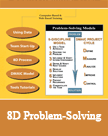This course teaches how to solve problems in a team setting using the 8-D (8-Discipline) problem-solving method. The course includes tutorials on dozens of problem-solving tools that help identify, analyze and fix problems.
All courses also feature:
- Tracking of training including student test scores and bookmarks.
- Complete documentation for ISO 9001 (and other standards) required records.
- With our web-based training, you can manage students for an entire corporation through one web-based account.
- Media-rich presentation including full audio and graphics.
- Exercises throughout to help reinforce learning.
- Solid technical content presented in an interesting and informative way.
- Complete student control to navigate through the program in a way that best meets the needs of the student.
- Certificates are awarded upon successful completion of courses providing documentation of Continuing Education Units that can be used for various professional certifications.
Course Objectives:
Students will be able to:
- Understand and use the 8D process to solve problems.
- Work on and contribute to a problem-solving team.
- Apply the appropriate problem-solving tools throughout the problem-solving process.
Intended Audience – All employees expected to use the 8-D Problem Solving Process.
Approximate Time To Complete – 7 hours.
- 30 Days Access to Training
- 30 Days Extension available
- Study Guide in PDF Format
- Certificate of Completion
- CEU’s – (.7)
Course Outline
Unit 1: Getting Started
- Lesson 1: Becoming Aware of a Problem
- Ways to recognize indications of problems.
- Ideas to help decide which problems to work on first.
- Lesson 2: Why Use a Structured Problem-Solving Process?
- How a formal problem-solving approach can improve the effectiveness of the whole organization.
- Building a common problem-solving language.
- Lesson 3: Do You Need a Team?
- Five questions to determine which problems need a team and which problems one person working alone can effectively handle.
- Lesson 4: The Importance of Data
- How data leads to information and information points the way to knowledge.
- Subjective versus objective data.
- Attribute data versus variable data.
- Using data to infer and make judgments.
- Lesson 5: Different Problem-Solving Models
- 8-Discipline Problem-Solving Model
- DMAIC Project Cycle
- Xerox Problem-Solving Process
- Boeing Process Flow for Working Projects
- A generic Six-Step Problem-Solving Model
- Unit Test: Problem-Solving Challenge
- An assessment of the student’s progress in this unit.
Unit 2: 8Discipline Process
- Lesson 1: Use a Team Approach
- Establishing team membership, roles of the members, boundaries of freedom for the team, and getting the team started up.
- Lesson 2: Describe the Problem
- Developing the Problem Statement.
- Lesson 3: Interim Containment
- Designing and putting temporary measures into place and verifying that they are working.
- Lesson 4: Define the Root Causes
- Using a systematic approach to collect, display, and analyze data to identify the root cause(s).
- Verifying that the cause identified is truly the root cause.
- Lesson 5: Develop Solutions
- Finding a solution to attack the root cause and correct the problem.
- Using mistake-proofing techniques.
- Lesson 6: Implement the Solution
- Developing simple and complex action plans.
- Using Gantt and PERT Charts to plan the implementation and monitor progress.
- Lesson 7: Prevent Recurrence
- Finishing the job to ensure the problem does not come back.
- Ensuring training, audit practices, and knowledge transfer are completed.
- Lesson 8: Congratulate the Team
- Providing recognition for the problem-solving team.
- Ensuring the problem-solving team recognizes those that have assisted them.
- Unit Test: Problem-Solving Challenge
- An assessment of the learner’s progress in this unit.
Compare Products
| Individual Classes |
30 Day Extension |
|
|---|---|---|
| Number of Classes | 1 | 1 |
| Price/Class | $99.00 | $59.00 |
| Number of Days | 30 | Additional 30 |
| Total Price: | $99.00 Order Now! |
$59.00 Order Now! |




